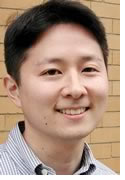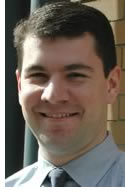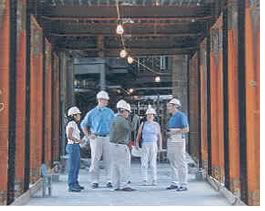
Through simultaneous top-down and bottom-up drivers, this year's Intern Development Program Outstanding Firm Award recipient, Payette Associates, designed a way to bring interns together with mentors and archive the shared knowledge. To find out how that program came together, and how Payette is sharing through the Boston Society of Architects, AIArchitect turns to three firm employees active in IDP.
Jonathan Kanda, AIA, was newly licensed, and Jeffrey DeGregorio, Assoc. AIA, was a Payette intern when they brought forth an idea two years ago. They turned to George Takoudes, AIA, a firm associate, to help them make it a reality. With a plan in hand to hold regular education programs for the firm's interns in a format tied closely to IDP requirements, they approached the 150-person firm's top leadership. Here are their stories.
 Developing
a Program Using Architectural Problem Solving
Developing
a Program Using Architectural Problem Solving
by Jonathan Kanda, AIA
With a lot of background help from George Takoudes on how to make something like this fly in the company, Jeff and I created a fairly formal presentation to the office. We wanted to show them that we'd done our homework. We outlined everything from a mission statement to the structure and organization of how the Young Designers Core (YDC) would work. We tied it into IDP and showed how it would benefit interns and the office at large. We were proposing an organization within the company that would help link all the various levels of the firm together, which turned out to be the biggest selling point.
As with any design problems, we began with a problem statement. The principals and associates already had their respective organizational groups with regular meetings on current activities. Yet here was a large portion of the firm—the young designers—without an organizational structure and with a variety of experience and training levels. We needed focus, attention, and a voice in the office; organized intern education and training to put a good solid foundation to the firm's work; freer knowledge-transfer among people in the office; and a way to archive the information being shared.
Our schematic solution was to get a group going. Payette Associates has always had a culture of learning and mentoring. The YDC was a way to organize it. So we proposed to the principals that we would organize this group of interns to help them get through IDP and the ARE. At the same time, this would benefit the office in terms of project performance.
Originally, Jeff and I planned for twice-a-month learning events. Jim Collins, our president, challenged us to meet every week. We agreed that would be great. There is something going on every day in this office, and we knew there would be at least one opportunity each week for learning and training. So, in the design development phase, we refined our plan to once-a-week events, if not more, and structured it closely around the IDP, including a matrix showing events on the y-axis and IDP categories on the x-axis.

I'd say we are still in construction contract administration
with this program. Among the benefits I see in it so far, three stand
out:
1. People are getting introduced
earlier to a lot more topics related to IDP than when I was preparing
for the ARE, which was before the YDC was created. Now there are project-management
and contract-negotiation seminars, for instance, which are among the especially
hard-to-fulfill IDP categories.
2. A more ephemeral benefit has
been increased communication. The YDC has created relationships in the
office horizontally among the young designers in different studios and
vertically up the ladder so that a young designer now has firsthand introduction
with principals and the associates. Cross-communication is much easier
because we've crossed that threshold of appreciating what others in the
firm know and are interested in knowing.
3. Cross-cultural communication
with other Boston architecture firms is something we're trying out, too.
Recently we sponsored a co-tour of a building that another office had
done. We met with their young designers group at the site and extended
our appreciation of learning opportunities beyond our own firm's work.
Not incidentally, it has taken the constant attention of two people to make this program work properly. Some events are easy—when someone has a presentation already prepared, for instance. Bringing in outside speakers requires a little more homework. Jeff and I usually go and meet with the person; even go through a dry run of their presentation just to make sure that they're focused on our audience, young designers.
The time we put into the YDC is our own. We consider it to be our contribution to the firm. But in terms of other support—if we need to rent cars, food, or any other tangible resources—the firm has backed us up completely.
 In
a Culture of Learning, Everyone Contributes and Benefits
In
a Culture of Learning, Everyone Contributes and Benefits
by Jeffrey DeGregorio, Assoc. AIA
When we first took on this commitment, Jon and I immediately attacked some of the more difficult IDP categories for interns to get. We invited our financial officer to talk to the group and recruited people out in the field, including subcontractors and manufacturers, to come talk with the group. On a day-to-day basis, interns would have a difficult time getting in contact with these people.
Our commitment is above and beyond the expectations that our supervisors have of our role in the office. It's very important to understand that before you start something like the YDC, you have to find people who are incredibly tenacious about making a commitment to following this through. We do programs at least once a week, and it takes a certain amount of commitment because this is definitely on our own time.
 I
should point out that people here are willing to give us some latitude.
For example, if I need to take a half hour with Jon to go talk with somebody
in the office about a presentation they're about to give, they understand
that. And we make it up over the course of the week. It's not too difficlt.
And the rewards are worth it in the end. YDC augments the culture of this
firm. Mentorship, teaching, and being a learning profession are time-honored
traditions within architecture that we need to continue.
I
should point out that people here are willing to give us some latitude.
For example, if I need to take a half hour with Jon to go talk with somebody
in the office about a presentation they're about to give, they understand
that. And we make it up over the course of the week. It's not too difficlt.
And the rewards are worth it in the end. YDC augments the culture of this
firm. Mentorship, teaching, and being a learning profession are time-honored
traditions within architecture that we need to continue.
We also archive everything that we do on the YDC site, which Jon and I maintain on the Payette intranet. We document every seminar and pictures of all YDC site visits. Anytime someone does a Powerpoint presentation or has a handout, we immediately put it into the site. If there isn't a handout, we list a contact person or make links elsewhere on the firm's extensive intranet knowledge base. We also keep a schedule of all upcoming YDC events.
Interestingly, the process of bringing all this material together in a comprehensive book for the IDP-award submission also helped us see the bigger picture. There is an incredible amount of experience and knowledge in this firm, and while we are helping disseminate that through mentorship and seminars, the archiving ensures that the information is going to be there for the long haul. So we're not just helping the people who heard the presentation. People who subsequently come into the firm can go to the archive, look at presentations, read up on a collected mass of information, and identify people to talk with directly.
 The
AIA Helps Out Where Some Firms Cannot
The
AIA Helps Out Where Some Firms Cannot
by George Takoudes, AIA
YDC has become the cornerstone of the premise that Payette is a terrific place for interns to learn about providing broad-based services and broad-based excellence.
It is only one part of our staff-development strategy in recent years, though. Additionally, the firm pays for taking the ARE. And part of our yearly employee performance reviews specifically addresses fulfillment of IDP requirements. So now reviewers are aware of where interns are in terms of experience—where they're lacking and where they're not. The interns have organized pinups on design as well, one of the areas I felt I was losing touch with when I went through the internship experience.
Much of this is a result of Jon and Jeff's work and the work of the Payette Associates' task group on staff development, which I had been chairing. In that respect, the YDC group was at once a grassroots development coming from interns and a top-down development from our principals and associates groups. This simultaneous development is the best-case scenario.
Jon and Jeff taking on the volunteer positions that this required made it a lot easier to set the presentation up for President/CEO James Collins Jr., AIA; COO Robert Mattox, FAIA; and Human Resources Director Lennie Murphy—the three key people who needed to buy into this system.
 It
was a pretty easy sell because it's a win-win. Of our design staff at
any one time, 30 to 40 percent are zero to five years out of school. They
are good, young, talented people. And when you're looking from an HR or
staff-development perspective, it makes a lot of sense to have a program
that in one fell swoop benefits a third of your company.
It
was a pretty easy sell because it's a win-win. Of our design staff at
any one time, 30 to 40 percent are zero to five years out of school. They
are good, young, talented people. And when you're looking from an HR or
staff-development perspective, it makes a lot of sense to have a program
that in one fell swoop benefits a third of your company.
Sharing and archiving the firm's collective knowledge is another added benefit. We're in three different design studios—architecture, landscape, and interiors—and each studio was doing their own training. It got frustrating when we were not leveraging the intelligence of the office by all sharing and taking on the approach of a teaching firm. If one studio had a terrific lunch presentation, only a third of the office benefited. That's no longer the situation.
From the principals' perspective, another major benefit is having the attention of all the junior staff at once. It's frustrating and counterproductive to have to, for example, explain bathroom layout individually to every intern who has to draw one. One of the first presentations we had therefore, was bathroom layout. Then the next presenter may talk about hospital and lab planning, which is one area where we have world-renowned experts. So the principals get a consolidated audience and the interns get a variety of very practical information.
Professional responsibility
This is great for a 150-person firm, which has the initiative and ability
to meet the professional responsibility of training interns. What of the
interns who find themselves in firms that cannot or will not provide adequate
training? One of my outside interests is in how the AIA plays a role in
picking up this baton.
While we were developing Payette's in-house program, I was working with the Boston Society of Architects on the Young Designers Professional Development Institute, which is now in its fourth session. What we did was pull together a 12-part lunchtime series over the course of a year through which the BSA provides training for folks who don't feel as if their intern development has been adequate.
The Young Designers PD Institute is based on the idea that people should be able to work in any firm they choose and still get help in bridging that gap from zero to five years that is so filled with angst. It only makes sense that the professional organization would be the right group to help interns bridge this gap.
If there's one lesson I learned going through all this, it's that IDP does a wonderful thing for interns. It provides the structure we need. And, therefore, anything that both the professional society and firms can do to support the IDP process makes all the sense in the world. It's a terrific program for a lot of reasons.
Copyright 2002 The American Institute of Architects. All rights reserved.
![]()
|
All photo credits are Photos courtesy of Payette Associates. The AIA convention in Charlotte will offer a variety of learning opportunities for interns. The AIA National Associates Committee, for example, is offering "Associates in Alternative Careers: Diversity in a Growing Profession" (FR31), Friday, May 10, 2–3:30 p.m. For complete information, visit the convention site. To visit the AIA national component's storehouse of accumulated knowledge, take a look at the course lists on eClassroom. |
|